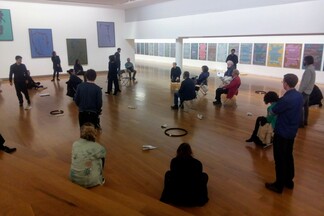
Audience and the musicians of Vertixe Sonora during the first performance at the Centro Galego de Arte Contemporánea.
Programme text for the premiere performance by Vertixe Sonora in a retrospective exhibition of the works of Portuguese painter Eduardo Batarda at the Centro Galego de Arte Contemporánea, Santiago de Compostela.
In her 2016 collection Calamities, author Renee Gladman is simultaneously writing to draw, and drawing to write, following the spiral of her hand until she is “writing-drawing” and finds herself drawing “something I had felt as I walked among buildings and perhaps something . . . Maria Helena Vieira da Silva had done” (115). What had Vieira da Silva done? In her works of the 1950s, she had done twisted geometries of depth and perspective, flinging the ghosts of some gothically fluid urban skeleton across the canvas, and it is these molten grids that Gladman finds herself tracing.
In the work Eduardo Batarda was making in the late 1980s, we find dark, striated canvasses, on the surface of which the ribs of some tangled structure have been illuminated by a wayward hand, and in following the swerve of each line as it weaves behind another, it is hard not to see his hand as haunted by Vieira da Silva’s. We might follow this line off the canvas and into genealogy, but this is not just a lineage of the eye. Instead, Gladman tells us how “drawing was a way to think with the body and writing was the story of the body in thought” (90). In her text, we move fluidly between image and word, from body to concept, and back again. Words can be chewed, swallowed, or spat out (95), and concepts can become “a grid of light” or “an opaque surface” given flesh and weight (34). Vieira da Silva and Batarda’s lines don’t simply appear similar to the eye; the lines of one artist pass into the body of another, such that the gestural compulsion of one day in 1953 weighs upon the flow of an arm in 1988.
So it is that Gladman’s “writing-drawing” can become a proposal for an act of the body: “‘It opens, and many people throw up their hands’ is a problem you insert into space” (124). As she finds a way to bring herself to the page in sentences, she is finding a way to lead us away from the page and into space. I borrow the title for this performance from Gladman and am grateful for the companionship of her writing, because her language makes the world ready to receive action and hands us problems to try and insert into space. I would also like to thank the musicians of Vertixe Sonora for their willingness to join me in this and for making space for my problems.